How Do You Know If Your Sewer Line Collapsed?
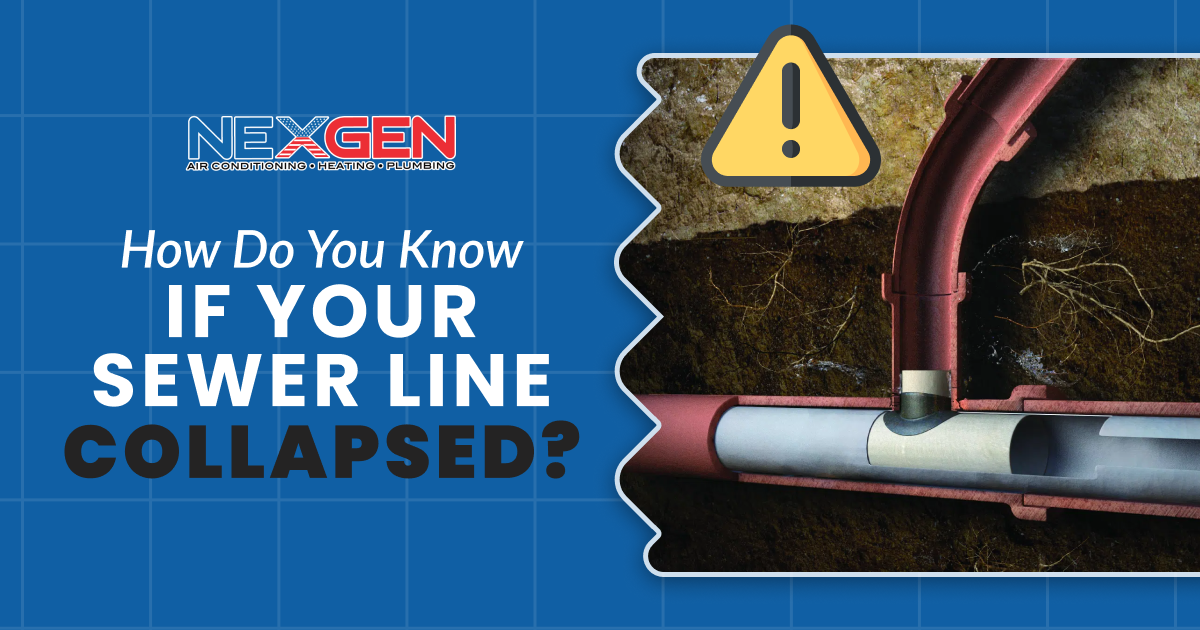
If your sewer line has collapsed, the effects are far worse than a clog. A collapsed sewer line can cause widespread problems throughout your home or business. The sooner you schedule sewer line replacement with a plumbing company in Southern California, the less costly the damage may be. Here are some telltale signs of a sewer pipe collapse so you know when to call for help.
Frequent Drain Backups
A backup can affect a toilet, sink, or bathtub. Frequent backups affecting the lower parts of your home are often due to a sewer line collapse. The collapsed section gives water nowhere to go. Instead of draining through the line, it builds up, reverses, and follows the path of least resistance.
However, the water may recede if dirt around the collapsed pipe slowly absorbs it. The signs of a problem may progress slowly over time, depending on where the collapse occurs.
Multiple Fixtures Clog Up
Every drain in your home connects to the main sewer line. If it collapses, every drain can be affected. Therefore, if multiple sinks and toilets in your home are backing up, it’s safe to assume there’s a collapsed sewer line. Water may drain slowly or not at all. The issue can manifest in only certain drain outlets, so a plumber will need to perform a camera inspection to determine where the damage is.
Sewer Gas Odors in Your Home
The smell of sewer gas is a sure sign there’s damage to the sewer system. Sewers are normally airtight except for the vent stack. A sewage backup not only smells bad. It contains bacteria, gases, and other pollutants that can spread disease and cause other health hazards.
Your Plumbing Acts Strangely
A sewer line problem can cause a toilet to suddenly start bubbling. If you hear gurgling noises from the toilet when running the sink, something is awry. You may also hear strange noises throughout your plumbing system. There are many bends, turns, and connections in your plumbing, so the effects of a collapse can be unpredictable.
Lawn Grass Grows Out of Control
If the sewer line under it is broken, one area of your lawn may be overgrown with grass. A patch of vegetation over the line can grow uncontrollably and be saturated with water. Sogginess may or may not be obvious (sinkholes can form in the most extreme cases). But if you mow the grass and an area grows faster than other parts or a patch of grass becomes saturated and dies, call a plumber to determine if you need sewer line replacement.
Your Property Is Overrun with Insects and Rodents
Insects can easily get into cracked pipes and then breed and multiply rapidly in stagnant water. Rodents love the shelter of sewers. If there are small cracks, they can squeeze through and get into your home. Both can carry germs and diseases, which is another reason to have the sewer line fixed right away.
Structural Damage
If a sewer line under your property has ruptured, water may erode the soil, causing the ground to shift under your foundation. The concrete slab and supporting walls then settle. Cracks begin to form in the slab and on the walls. Gradually, the foundation loses the ability to hold the weight of the structure. Severe erosion and ground shifting can cause a building to collapse.
What Causes a Collapsed Sewer Line?
You may need sewer line replacement because the pipe collapsed due to tree roots breaking it up. Grease and other debris buildup can also cause a sewer pipe to collapse. Pipe erosion is a common cause as well.
How Can a Sewer Line Collapse Be Fixed?
The method used to fix the sewer pipe depends on the nature and severity of the problem. A plumber can use trenchless pipe lining, which involves using an epoxy liner to create a pipe within a pipe. Another option is pipe bursting, in which a new pipe is pulled through the damaged one, fracturing the old line and replacing the damaged portion. If neither of these methods can be used, the contractor may have to resort to digging and trenching to perform sewer line replacement.
How Much Does Sewer Line Replacement Cost?
The cost of fixing a collapsed sewer line varies considerably. Plumbing contractors usually charge by the linear foot, so the more piping they replace, the more expensive the job. The price of materials, location of the damage, and repair method used also affect the total cost of the project. Replacing a sewer line usually costs several thousand dollars.
Call NexGen for Sewer Line Replacement
The leading plumbing company in Southern California, NexGen has fully licensed and insured technicians ready to address the signs of a sewer line collapse. We provide 24-hour emergency plumbing services and specialize in various methods of repairing pipes. Our team is prompt and can quickly repair a damaged sewer line on a residential or commercial property. For immediate help, call (805) 301-6788 today.
Should You Repair or Replace a Leaking AC?
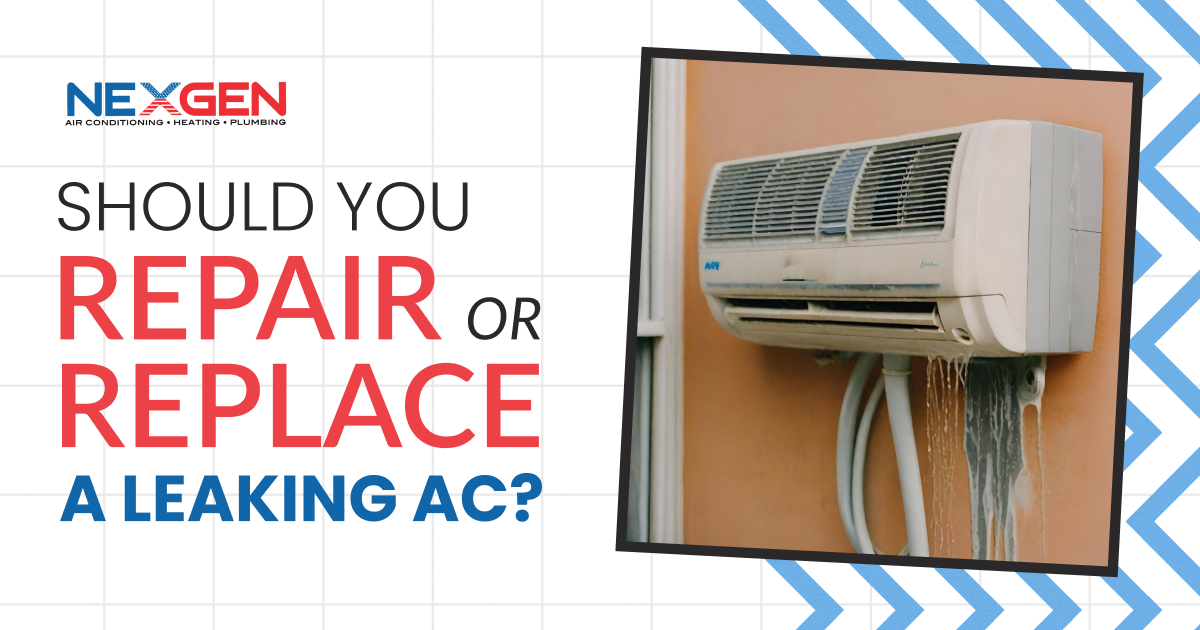
A refrigerant leak is a major problem and can leave you wondering whether to repair or replace your leaking AC. You’ll need an AC repair professional to help you decide. Refrigerant is a fluid that enables your air conditioner to cool down your home. Any AC unit can develop a leak, regardless of its age, due to corrosion, temperature extremes, and damage to coils. A leak should be considered an emergency; AC refrigerant is toxic and a loss of coolant can damage the system.
We’ll look at the following factors to help decide if a refrigerant leak warrants an AC repair or replacement:
Age of the System
Refrigerant leaks are more common in air conditioners that are five years old or more. Repair the issue if the system is relatively young. It probably has a fair amount of life left, especially if it’s less than 10 years old, so repairing a leak should be worthwhile. However, if you have an older AC, finding replacement parts may be prohibitively costly.
Cost of the Repair
A refrigerant leak can cause a considerable amount of damage. If it’s been occurring for a while, a lack of refrigerant has probably strained the system to the point major components like the compressor can fail. A compressor can be replaced. However, if your system is old and no longer under warranty, this approach is expensive.
Repairing a refrigerant leak can cost under $200 if the fix is simple. More complex jobs can cost $1,000 or more. If the job is complex and labor-intensive enough, it can cost nearly as much as replacing the entire system. As a general rule, choose a replacement if a repair estimate exceeds 50% of the price of a new unit. Or, multiply the repair cost by the unit’s age; if the result is $5,000+, replacement is more cost-effective.
Your Old AC Still Uses R-22
If your air conditioner is over 10 years old, it may use R-22 refrigerant. This product can no longer be produced legally in the U.S. Finding R-22 is extremely costly and most technicians won’t consider doing so. A more environmentally friendly refrigerant, R-410A, is readily available but can only be used in new ACs. You’re better off replacing an old AC that’s leaking.
The Cost of Your Energy Bills
How much do you spend on energy each month? Older ACs are generally less efficient than new units and even less so if there’s a leak. A technician can evaluate your system’s general efficiency rating and whether it’s properly sized for your home. If not, and several parts are worn out, and your energy bills keep going up, investing in a new AC can save you over time.
Efficiency ratings have changed over the years. Older units have lower SEER ratings, but modern ones must be rated at least 14 SEER in the North and 15 SEER in the South (as of 2023). High-efficiency models are rated at 20 SEER or higher.
Are You Planning on Moving?
If an AC repair to fix a leak isn’t prohibitively expensive, and you plan on moving within the next few years, you may not want to invest in a replacement. However, think of the condition of the system. If it’s been poorly maintained and in disrepair, not replacing it can reduce the sale price of your home. Even if you’re not planning on leaving, replacing it can provide peace of mind and avoid dealing with the hassle later.
Do the Indoor and Outdoor Units Match?
Indoor and outdoor AC units should be the same brand and model, but this isn’t always the case. If one component was replaced after the other, they may be incompatible, causing the system to run less smoothly and efficiently. And, if there’s a refrigerant leak, paying for a costly repair isn’t worth it. Installing a new, high-efficiency, perfectly matched system will save you energy and maintenance costs for many years.
Is It Still Under Warranty?
If the system is still under warranty, most repairs are worth it. But if the warranty has expired or is invalid, repairing a leak can be very expensive. Plus, if it’s out-of-warranty, chances are the unit has either been neglected or is too old to consider repairing. However, if you have an extended warranty and have properly maintained the system, that can delay your decision to replace it.
Contact NexGen for AC Repair or Replacement
NexGen provides AC repairs involving refrigerant leaks, condensate line clogs, and any other problems that arise. We also specialize in plumbing leak detection and repair. Our technicians are fully licensed and insured and available 24/7 for emergencies. They can diagnose and fix any problem and advise you on whether to replace an aging system. For high-quality AC repairs and free estimates in Southern California, call (805) 301-6788 today.
Source:
10 Reasons to Have a Sewer Line Cleanout Installed
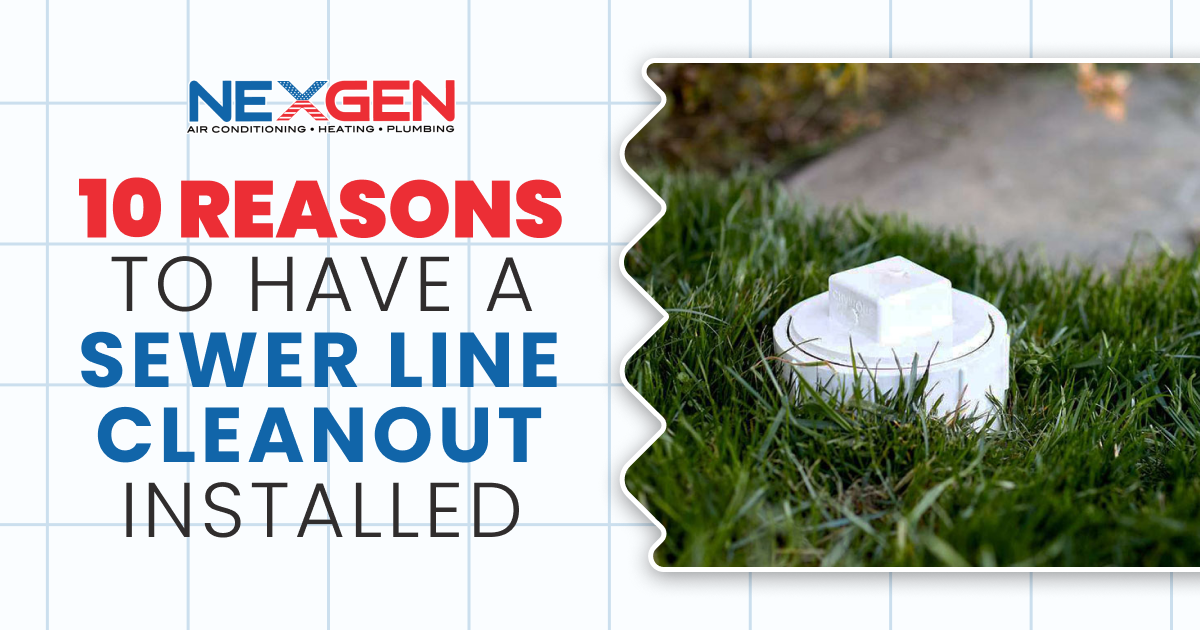
Installing a sewer line cleanout has many benefits when it comes to unclogging or maintaining sewer pipes. You need one if it’s not already installed. Sewer line clogs are often hard to locate and can be too deep for a plumbing snake to reach or for the force of a plunger to have any effect.
The cleanout is usually a 3-, 4-, or 6-inch pipe covered with a white, black, or gold plastic cap. It provides access to the sewer line at a connecting point between your house and the municipal sewer system. Usually found outside the home, it’s often near a basement window, in the yard, along a sidewalk, or where the pavement and lawn meet. An older home may have a cleanout inside.
You should have a sewer line cleanout for these reasons:
1. Emergency Access
A blockage or broken pipe can cause sewage to back up and flow into your home. The longer this takes to resolve, the more expensive repairs will be. A cleanout provides a plumber with immediate access to the sewer line and a closer point where they can reach and remove a blockage. They won’t have to excavate your yard to access the pipe.
2. Drain Problems Can Be Prevented
If you often deal with clogged drains, a sewer line cleanout enables a plumber to quickly detect where the problem is and address it more quickly. They can perform a better assessment and provide advice on how to prevent future drainage issues.
3. It Can Improve Safety
Sewer gas is toxic and can be extremely harmful. The cap on a cleanout prevents gases from building up and entering your home. Otherwise, they could seep through pipes, floors, and baseboards. Aside from smelling unpleasant, gases such as ammonia, methane, and sulfur dioxide can cause headaches, dizziness, eye irritation, nausea, vomiting, sore throat, and difficulty breathing; if the concentrations are high enough, you could quickly be rendered unconscious.
4. Your Plumbing Is Draining Slowly
Multiple slow or clogged drains point to a sewer line clog. If this is the case, sinks and toilets will be affected. Even if they’re draining slowly, a sewer line cleanout can enable a plumber to act quickly and avoid a complete blockage.
5. Water Is Backing Up Unexpectedly
A clogged toilet or shower will prevent water from draining from one location. But issues such as water appearing in a downstairs shower when you flush an upstairs toilet mean water is moving but not going as far as it’s supposed to. The backup is originating further down the line. The easiest place to determine where is from the cleanout.
6. Your Plumbing Can’t Handle Large Amounts of Water
Running a sink or flushing a toilet may not cause trouble. But if you run multiple fixtures or a large washing machine load, and a backup occurs, don’t ignore the issue. You may just be tempted to reduce the load on the system. A sewer line clog will only get worse, and installing a cleanout can help manage it.
7. The Yard Is Flooding
The pressure from a blockage can cause the main sewer line to break. Water will then emerge outside. If this happens, your yard may appear damp even if it doesn’t rain. Lush patches of greenery can also mean sewage is leaking. The closer a plumber can get to the problem, the more quickly they can resolve it.
8. Mold and Mildew Are Growing In Your Home
Water can back up into your home and not cause plumbing problems. However, excess moisture can allow mold and mildew to grow. If left unchecked, they can do extensive damage, including the foundation, and cause health issues. When you see mold growing, call a plumber to find out why.
9. Flooding Can Be Avoided
A single flood, even if the water doesn’t get that high, can ruin furniture, carpets, flooring, and building materials. The small blockage growing in your sewer line can be a precursor to a flood. With a sewer cleanout, a professional can reach the affected area and fix the problem before it becomes a disaster.
10. Plumbers Can Perform Routine Maintenance
Aside from dealing with emergencies, a sewer line cleanout makes it easier for a plumber to perform an annual sewer cleaning. They don’t even have to enter your home. Plumbing maintenance can address issues and prevent future clogs.
Call NexGen to Install a Sewer Line Cleanout
Installing a sewer line cleanout makes plumbing repairs and maintenance faster and more convenient. We can use this access point to conduct camera inspections, snake a sewer line, or perform hydrojetting. At NexGen, our technicians are trained in various methods of unclogging and cleaning sewer lines and can address tree root infiltration and other issues. To schedule drain and sewer line cleaning and other services, book your appointment online or call (833) 729-9735.
7 Signs to Call a Sewer Drain Cleaning Service Now
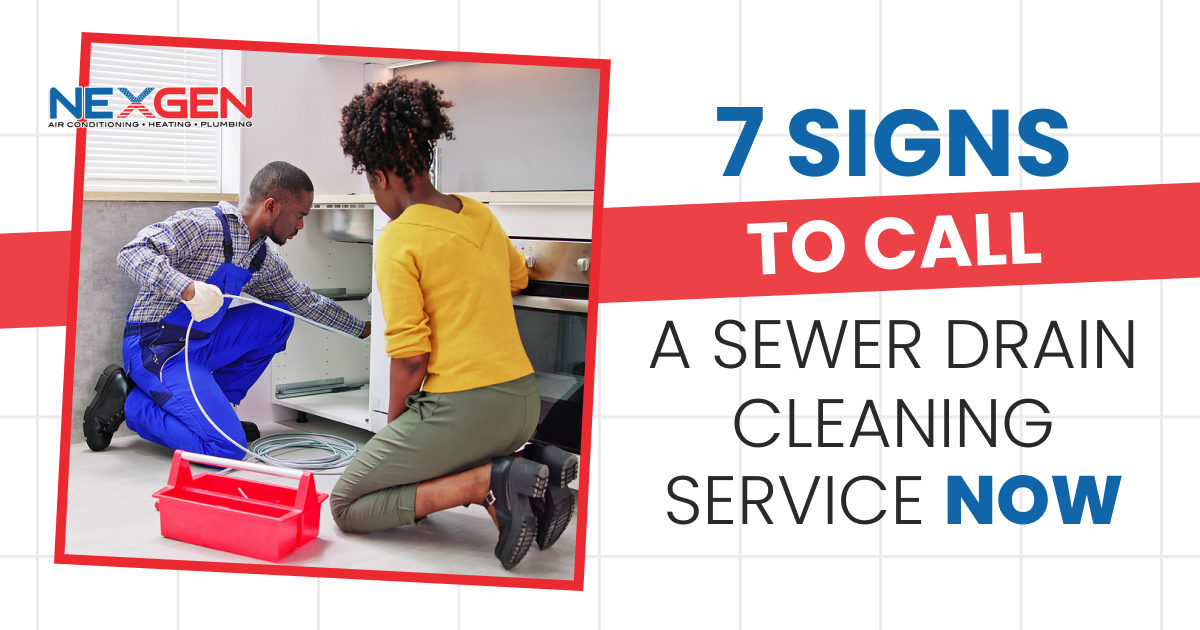
When there’s a drainage problem, it may be deeper than you think. A clogged sewer drain can cause wastewater to back up and overflow from any plumbing fixture. Fortunately, NexGen provides a sewer drain cleaning service to resolve or prevent messy, hazardous, or damaging situations. But you must know when to call so we can get there in time.
Here are seven signs you need a sewer drain cleaned now:
1. Multiple Fixtures Aren’t Working
A common sign of a clogged sewer drain is when more than one toilet clogs up. Toilets provide the most direct path to the sewer system. Thus, they’re the most reliable indicators of a sewer problem. Also, since shower and bathtub drains are lower than, for example, sinks, they’re more likely to be affected by clogged sewer lines.
2. Your Drains Are Slowing Up
If several drains are gradually getting slower, or the problem starts in one drain and spreads to others, it’s time to call a sewer drain cleaning service. As your main sewer line blocks off, water will take longer to go down. The sooner you call a professional, the more likely you can avoid a complete blockage or backup.
3. Drain Clogs Occur Frequently
The occasional kitchen or bathroom drain clog isn’t something to panic about. It’s usually easy to fix. But if you find yourself using plungers and drain cleaners more frequently, a sewer line clog or other problem may be the cause.
4. Plumbing Fixtures Are Acting Strangely
A clogged sewer drain can cause a tub or shower drain to overflow when you flush the toilet. The water from the toilet can’t drain, so it’ll back up at the lowest point. Or, the toilet may overflow when you run the washing machine. Another indication of trouble is when water in the toilet starts bubbling when you use the bathroom sink. It means air is trapped in the plumbing system, most likely due to a clogged sewer drain.
5. There’s a Pungent Odor In Your Home
Stronger and more persistent odors than usual from your toilet mean your sewer line needs to be serviced, especially if these smells are also emanating from your sink or shower drain. Exposure to sewer gas can cause eye irritation, coughing, and difficulty breathing. It can also lead to headaches, fatigue, dizziness, nausea, and trouble concentrating. Even a small amount of sewer gas can be hazardous. High levels can be fatal; if methane is present, sewer gas can also be explosive. Call for help!
6. Your Yard Is Soggy or Flooded
A wet yard isn’t usually a concern after it rains. But if there are wet spots during dry weather and all these spots align with the path of your sewer pipe, suspect a leak and call a plumber. A leak is possible whether there are sewage odors or not.
7. Water or Waste Back Up from the Clean-Out
Check the main line clean-out if you suspect a sewer line clog. Water should not flow to the top or spill out when you open the cap. If it has reached the top or you can see standing water inside, call a professional to address the clog.
Call NexGen for Sewer Drain Cleaning Service
No matter what’s clogging a sewer or other drain, our experienced plumbers can remove it and get your drainage system working again. We can use advanced snake equipment or a hydro jet machine at your sewer clean-out to resolve the issue. If the source is unknown, we’ll use a specialized fiber optic camera to identify it. To request 24/7 drain cleaning or other emergency plumbing services in Southern California, call (805) 301-6788.
How Do Tree Roots Get Into Sewer Lines?
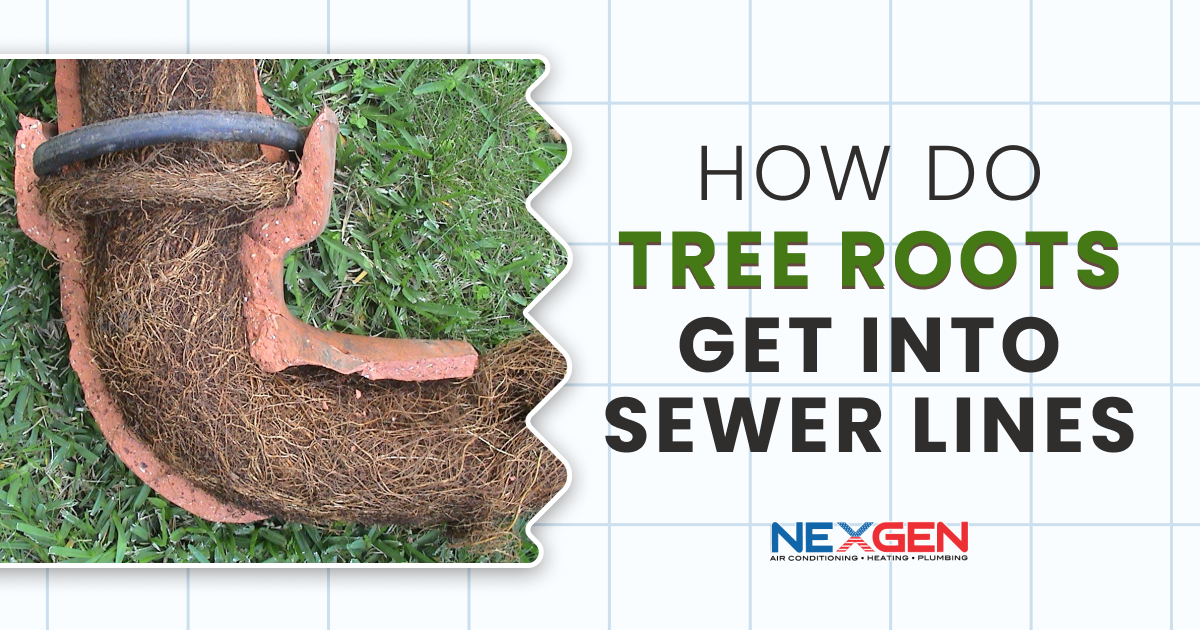
Trees can add shade and beauty to your property. They’re also good at boosting curb appeal. But they’re often not a benefit for your sewer pipes. Tree root intrusion is a more common problem than many people realize. When a customer learns their plumbing woes are caused by tree roots, they often ask, “How do tree roots get into sewer lines?”
To answer that question, let’s first look at how tree roots work. Any tree requires enough water to survive. Water contains the moisture, nutrients, and oxygen needed for a tree to grow and sustain itself (roots naturally grow toward water sources). Sewer lines contain all of these. And just like tree roots, they’re contained underground.
How do roots find the sewer line in the first place? We’ll now explain this in more detail:
The Sewer Pipe Is Damaged
A pipe can develop holes or crack due to corrosion. Ground movement and settling can cause damage as well. No matter how minute an opening is, it can release enough water to attract roots. And the roots can use this entry point to grow into the pipe, fill it up, and catch grease, oil, fats, dirt, and other materials that contribute to a blockage.
But the sewer line doesn’t have to be leaking or broken to attract tree roots.
Sewer Vapors Are Released Into the Soil
As water flows through a pipe, moisture-, oxygen-, and nutrient-filled vapors can escape into the soil, even if there isn’t a true leak, and reach nearby roots. Sensing the direction these vapors came from, roots grow toward the sewer pipe. Tree roots are strong and persistent. They can sometimes break into or crush a pipe; or, if there’s a loose joint or connection, push it apart and begin to grow inside.
Can I Stop Tree Roots From Getting Into Sewer Lines?
If tree roots have reached or gotten into a sewer line, the pipe must be repaired by a professional plumber. Only they have the experience, knowledge, and tools to resolve the problem. Avoid using chemical solutions. They can poison the tree and contaminate the environment. Plus, depending on what the pipe is made of, chemicals can do more damage. If a pipe is already weakened, chemicals can cause it to break down and fail.
However, there are safer ways to prevent tree roots from affecting sewer lines, including:
- Planting Trees Far from the Line: When you plant a new tree, know the location of your sewer line first. Don’t plant the tree nearby. The farther you position trees in your landscaping from a sewer line, the less likely they’ll affect your plumbing.
- Scheduling Annual Plumbing Inspections: During an annual inspection, a technician can run a camera through your pipes to check for blockages and damage. Small issues can be fixed before major plumbing problems occur.
- Replacing Broken Pipes: If you know there’s a drip, crack, or fracture in a sewer line or a pipe has started to corrode, have it replaced by a professional. Prompt repairs reduce the risk of having to ask, “How do tree roots get into sewer lines?” and can increase your plumbing system’s lifespan.
How Do I Know Tree Roots Are In My Sewer?
Aside from a plumbing camera inspection, there are other ways to suspect a tree root problem. Common signs of tree roots in a sewer line include backed-up toilets or plumbing fixtures, soggy areas on your lawn, and frequent drain clogs. The smell of sewage in your home means a sewer line has been compromised. Other signs of damage can range from as subtle as a gurgling toilet to visible water damage along your home’s foundation.
Call NexGen for Tree Root Removal
At NexGen, we provide safe and effective tree root removal services in Southern California. We can use a drain snake with a rotating cable, a rooter machine, or hydro jetting to break up tree roots. Our licensed, insured technicians also fully repair affected sewer lines and take preventative measures to inhibit future intrusions. To learn more or schedule professional tree root removal on your property, contact us online or call (833) 729-9735.
How Much Does A Drain Camera Service Cost?
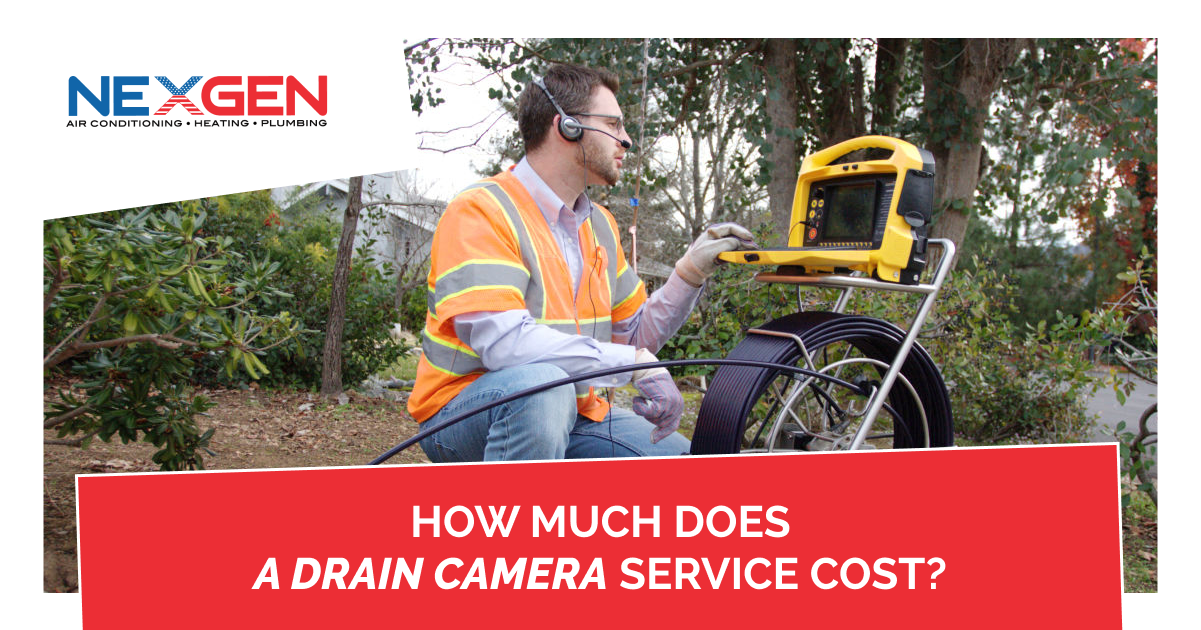
A drain or sewer camera inspection can save you a great deal of money. It helps find localized issues, that if not fixed, can lead to thousands of dollars in repairs. The cost of drain camera service is nowhere near as costly.
According to Forbes, the average cost of a sewer camera inspection in 2022 was $280. On the low end, it could cost as little as $70. While the average price range was between $125 and $500, some inspections cost up to $900 depending on rates, the scope of services provided, and the state or city.
The Variable Cost of Drain Camera Service
The cost of service can vary considerably. A drain camera inspection, according to Angi, averages $685 nationally but can cost as high as $1,175. If repairs are needed the cost will be higher. For example, the cost of materials and labor will increase the price if a toy was accidentally flushed by a child, a drainage or sewer pipe is leaking, or tree roots have gotten in. Plumbers can charge between $45 and $150 per hour so this is something to consider.
Location Matters
As we’ve said, location will impact the cost of a pipe camera inspection. In Orlando, FL, the average was about $315 while in New York City it was $510. Meanwhile, customers in Los Angeles may pay $1,600 and those in Seattle paid an average of $1,535. However, in Pittsburgh, PA, the average price of a camera inspection was a whopping $2,315.
Do I Need a Professional?
A drain camera inspection requires dedicated equipment. Technically, most people can perform an inspection. But this means having to purchase the equipment yourself, which can cost up to $15,000, plus the cost of a video monitor, output, and lighting equipment (rentals are available but cost around $200 per day). There are more affordable camera inspection systems. However, video resolution, reach length, and options for retrieval devices will be limited.
Other Drain Camera Service Cost Factors
When a plumbing company sets its prices for inspecting drains and sewers, here are some other considerations in deciding what to charge:
- Accessibility: Access points, including sewer cleanouts, make it easier for a plumber to insert the video equipment into a pipe. Limited accessibility can complicate matters. The company will have to increase your bill for the additional time and labor, as it may be necessary to remove a toilet or other fixture (then re-install it) to access the sewer line.
- Sewer Length: The farther the camera has to go, the more time the inspection will take. That means paying more for the service. But that’s not your fault. You probably have no idea how long your drain or sewer lines are.
- Bundled Services: Some plumbing companies bundle video inspection with cleaning and maintenance services. They may even include object retrieval or minor repairs in the price. While the service may cost more overall, the cost per task will be less than if you paid for each individually. A plumber may also include drain camera service as part of a new home inspection.
- Type of Equipment Used: It’s typically less costly to use snake cameras (around $40 to $160), but they generally don’t reach that far. Rigid boroscopes offer sharp images and are best for straight piping, but can cost up to $1,700. A CCTV sewer camera can cost up to $10,000 or more, so a plumber will have to consider that.
Call NexGen for High-Quality Drain Camera Service
At NexGen, we use the most state-of-the-art drain and sewer inspection equipment. Fiber optic cameras on long, flexible cables provide crisp views of the interior of pipes so we can quickly identify any problems deep in a drain or sewer line. This avoids digging and lets us make quick repairs at reasonable prices. To schedule a drain and sewer camera inspection in your Southern California home, book a date/time online or call NexGen at 805-301-6788 today.
Benefits of Sewer Camera Inspection Services
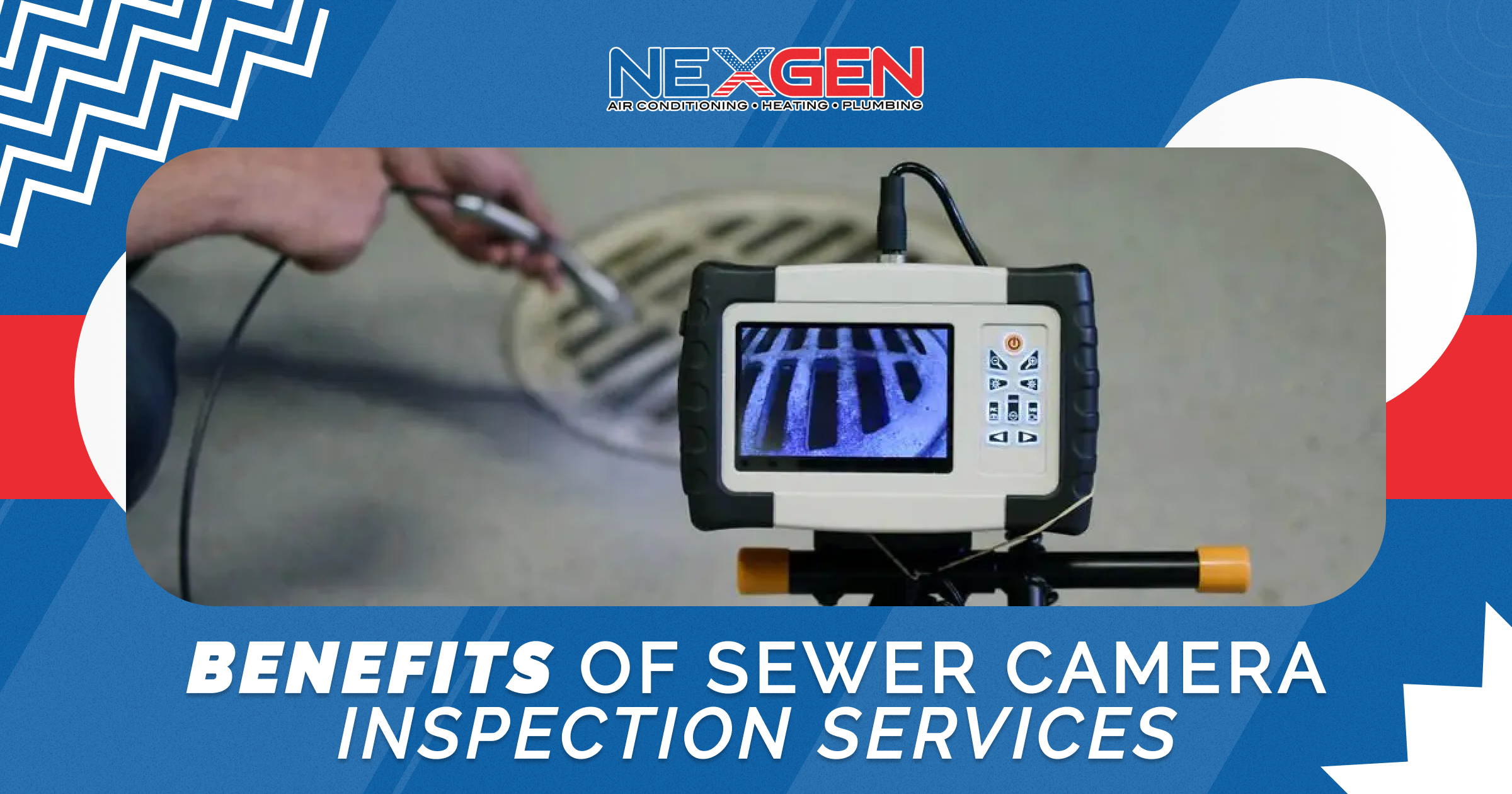
Sewer pipes are buried underground and thus hidden out of sight. Before video camera inspection, the only way to assess their condition was to excavate the ground around them. But now, whether a plumbing issue must be investigated or it’s time for maintenance, you can rely on sewer camera inspection services. A high-resolution camera, attached to a flexible cable, provides a view deep into the sewer system, in real-time.
The benefits of this process include:
No Trenching Is Required
A sewer line can be inspected without invasively digging trenches across yards and landscaping. Equipment is placed in the line via a cleanout or other access point. Once the camera begins transmitting video to a handheld monitor, the technician can immediately start assessing the condition of a pipe. Therefore, sewer camera inspection eliminates a lot of labor and saves a great deal of time.
Numerous Issues Can Be Found Quickly
Issues such as leaks, clogs, and cracked, corroded, or collapsed pipes can be identified wherever in the line they may be. Crushed, bellied, or disconnected pipes can be found as well. And if tree roots have intruded into a sewer line, they’ll be seen right away so a plumbing contractor can get started in removing them. Whatever the situation, your plumber will be able to diagnose it immediately and determine a solution to resolve it.
Property Damage Can Be Avoided
A sewer backup can flood your home with contaminated and even toxic water. Your yard or landscaping can be flooded as well. In addition to being a major health hazard, wastewater can seriously damage floors, walls, ceilings, furnishings, foundations, or anything else that’s in the way. It can introduce bacteria and harmful chemicals as well as cause mold. In extreme cases, water damage can compromise the structural integrity of your home.
It Can Determine If Trenchless Repair Methods Are Possible
A visual look at the issue allows a plumber to decide how to fix it. For example, they can tell whether inserting a pipe liner will restore the sewer line. Perhaps hydro jetting can be used to remove clogs and buildup. Trenchless methods save time and money while eliminating any further concerns over potential impacts on your home plumbing system.
Sewer Camera Inspection Services Are Affordable
The costs of digging, property repair, and extensive labor are removed. Since trenches don’t need to be dug or filled, the process is relatively quick. And because camera inspection spots issues fast, more serious issues and potential sewer line failures can be avoided. That can mean preventing future problems such as slow drains, sewage backups, water damage, and home cleanup and restoration.
A Plumber Can See Exactly What Is Blocking the Sewer Pipe
Sewer pipes can develop many kinds of blockages. Soap scum, cooking grease, trash, food items, and many other compounds can build up on pipe walls over time. Camera inspection helps spot accumulated gunk and grime so a plumber knows when to clean the pipe and avoid a major blockage. They can also determine whether it’s time to repair or replace a sewer pipe.
Contact NexGen to Schedule Sewer Camera Inspection Service
We use state-of-the-art technology to inspect sewer lines. Fiber optic cameras provide high-resolution, real-time views from inside, while the fiber optic cables we use extend for hundreds of feet. Our process is fast, accurate, and effective in helping us determine how to fix the problem, whether there’s a leak, clog, or mineral buildup. We can find its exact location and also accurately map your drainage and sewer lines.
To schedule drain and sewer camera inspection services, book an appointment online or call 833-729-9735 today.















